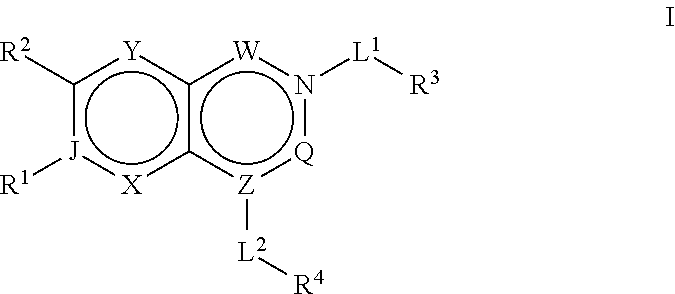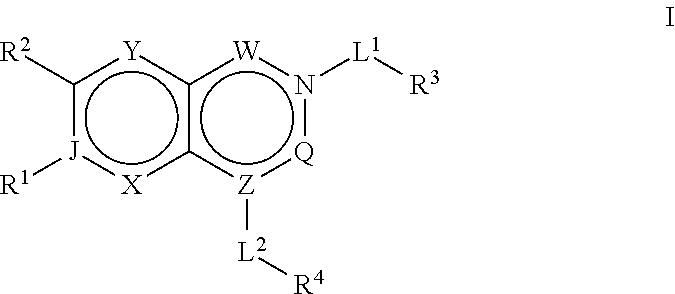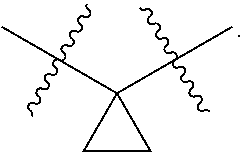Acc inhibitors and uses thereof
a technology of acc inhibitors and inhibitors, applied in the field of acc inhibitors and uses thereof, can solve the problems of not providing the long-term health benefit needed for sustainable weight loss, reducing the quality of life dramatically, and increasing the risk of type-2 diabetes (t2dm), stroke and coronary heart diseas
- Summary
- Abstract
- Description
- Claims
- Application Information
AI Technical Summary
Benefits of technology
Problems solved by technology
Method used
Image
Examples
example 1
Synthesis of Compound (R)-2-(1-(2-(5-fluoro-2-methoxyphenyl)-2-((tetrahydro-2H-pyran-4-yl)oxy)ethyl)-6-(oxazol-2-yl)-2,4-dioxo-1,2-dihydro-quinazolin-3(4H)-yl)-2-methylpropanoic acid, I-28
[0330]
[0331]Synthesis of compound 1.2. Into a 100-mL 3-necked round-bottom flask, were placed compound 1.1 (5 g, 23.14 mmol, 1.00 equiv) and ethanol (100 mL). Hydrogen chloride gas was introduced and resulting solution was refluxed overnight. The reaction was then quenched by the addition of saturated sodium bicarbonate and solvents were removed under vacuum. Crude was purified using flash column chromatography to provide 2.5 g (44%) of compound 1.2 as a yellow solid.
[0332]Synthesis of compound 1.3. Into a 100-mL 3-necked round-bottom flask, was introduces compound 1.2 (2.5 g, 10.24 mmol, 1.00 equiv), dichloromethane (50 mL) and triphosgene (1 g). This was followed by the addition of Et3N (3.1 g, 30.64 mmol, 2.99 equiv) dropwise with stirring at 0° C. The resulting solution was stirred for 1 h at 0...
example 2
Synthesis of (R)-2-(1-(2-(5-fluoro-2-methoxyphenyl)-2-((tetrahydro-2H-pyran-4-yl)oxy)ethyl)-6-(oxazol-2-yl)-2,4-dioxo-1,2-dihydroquinazolin-3(4H)-yl)-2-methylpropanamide, I-29
[0340]
A 8-mL vial, was charged with compound I-28 (150 mg, 0.26 mmol, 1.00 equiv), DCC (108 mg, 0.52 mmol, 1.98 equiv), 4-dimethylaminopyridine (65 mg, 0.53 mmol, 2.01 equiv), dichloromethane (3 mL) and NH4Cl (28 mg, 0.52 mmol, 1.98 equiv.). Reaction was stirred overnight at 50° C. in an oil bath. The resulting mixture was concentrated under vacuum and crude was purified via flash column chromatography to provide 61.5 mg (R)-2-(1-(2-(5-fluoro-2-methoxyphenyl)-2-((tetrahydro-2H-pyran-4-yl)oxy)ethyl)-6-(oxazol-2-yl)-2,4-dioxo-1,2-dihydroquinazolin-3(4H)-yl)-2-methylpropanamide, I-29, as a white solid. LCMS (ES, m / z): 589 [M+Na]+; 1H NMR (300 MHz, DMSO-d6): δ1.11-1.14(m, 1H), δ1.28-1.31(m, 1H), 1.54-1.69(m, 8H), δ3.16-3.29(m, 2H), δ3.46-3.47(m, 1H), δ3.46-3.68(m,2H), δ3.71(s, 3H), δ4.11-4.21(m, 1H), δ4.23-4.41(m, ...
example 3
Synthesis of (R)-2-(6-bromo-1-(2-(5-fluoro-2-methoxyphenyl)-2-((tetrahydro-2H-pyran-4-yl)oxy)ethyl)-2,4-dioxo-1,2-dihydroquinazolin-3(4H)-yl)-2-methylpropanoic acid, I-30
[0341]
[0342]A 25-mL round-bottom flask was charged with compound 1.8 (100 mg, 0.12 mmol, 1.00 equiv), THF (5 mL) and TBAF (100 mg, 0.38 mmol, 3.13 equiv). The resulting solution was stirred overnight at room temperature. Upon completion reaction was quenched by the addition of 10 mL of water and extracted with 2×10 mL of ethyl acetate. Organic layers combined and solvents under vacuum. The crude was purified by preparative HPLC to provide 64 mg (90%) of (R)-2-(6-bromo-1-(2-(5-fluoro-2-methoxyphenyl)-2-((tetrahydro-2H-pyran-4-yl)oxy)ethyl)-2,4-dioxo-1,2-dihydroquinazolin-3(4H)-yl)-2-methylpropanoic acid, I-3, as a white solid. LCMS (ES, m / z): 579 [M+H]− 601 [M+Na]+; 1H NMR (300 MHz, DMSO-d6): δ1.11-1.32(m, 2H), 1.54-1.69(m, 8H), δ3.12-3.32(m, 3H), δ3.43-3.56(m, 2H), δ3.74(s, 3H), δ4.05-4.42(m, 2H), δ5.09-5.13(m, 1H),...
PUM
| Property | Measurement | Unit |
|---|---|---|
| Pharmaceutically acceptable | aaaaa | aaaaa |
| Disorder | aaaaa | aaaaa |
Abstract
Description
Claims
Application Information
 Login to View More
Login to View More - R&D
- Intellectual Property
- Life Sciences
- Materials
- Tech Scout
- Unparalleled Data Quality
- Higher Quality Content
- 60% Fewer Hallucinations
Browse by: Latest US Patents, China's latest patents, Technical Efficacy Thesaurus, Application Domain, Technology Topic, Popular Technical Reports.
© 2025 PatSnap. All rights reserved.Legal|Privacy policy|Modern Slavery Act Transparency Statement|Sitemap|About US| Contact US: help@patsnap.com



